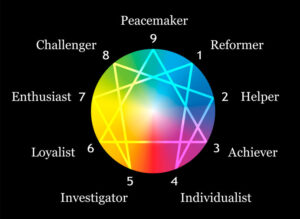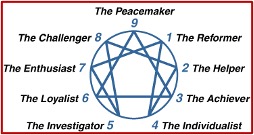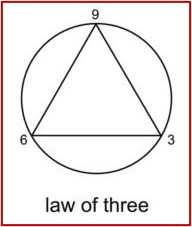Is the Enneagram Spiritually Neutral? Part 3
Despite claims of having an ancient origin, the Enneagram as it is known today originated with George Gurdjieff, a Russian philosopher, mystic and spiritual teacher, who introduced it to the West in 1916. Gurdjieff thought it could be used to disclose all knowledge and reveal the secrets of the cosmos. As the Enneagram of personality, it has become a popular ‘tool’ for personality assessment and spiritual growth and even found its way into the Christian church. Unfortunately, it seems many Christians are unaware of, or explain away the evidence of its occult origins and nature.
Marsha Montenegro Critiques the Enneagram
Attempts to sanitize the Enneagram of personality by claiming it was stolen from Christianity and is based on biblical principles are false. Marsha Montenegro, a former astrologer who was involved with various New Age, occult and Eastern beliefs and practices before coming to Christ, said its theories of personality are based on esoteric teachings and an occult worldview. Its Gnostic initiation or awakening “is an occult counterfeit of the indwelling of the Holy Spirit and His regeneration of the believer upon faith in Christ.” See her website, Christian Answers for the New Age (CANA) for several articles on the Enneagram.
The clear origin and purpose of the Enneagram is to initiate a Gnostic spiritual awakening to one’s alleged true divine Self, which is in itself an occult initiation. This is the claim and goal of virtually all occult and New Age teachings. The purpose of such initiation is a shift in consciousness, a change in the way one views reality — God, the world, others, and self.
The kind of Christianity claimed by Gurdjieff is a Gnostic distortion of Christianity. “Gurdjieff, his predecessors in Theosophy, and those who followed the various offshoots of Theosophy and related groups usually referred to themselves as Christians and believed they had discovered the ‘true’ Christianity.” Many who follow New Age belief systems or use ‘tools’ like the Enneagram will claim to be mystical or esoteric Christians.
Alisa Childers has a 13-minute video interview on her YouTube channel with Montenegro on how the Enneagram became part of Christian culture. Montenegro reviewed how Gurdjieff taught about the Enneagram to his students, including P.D. Ouspensky. Gurdjieff never wrote about the Enneagram, but Ouspensky did. Oscar Ichazo came across the teachings of Gurdjieff and Ouspensky on the Enneagram and incorporated his own understanding of the Enneagram as a “picture of Ego fixation.” Each of the nine points of the Enneagram corresponded to an Ego fixation—something your Ego becomes fixated upon. Ichazo’s view was that your Ego, who you seemed to be outwardly, was a cover up for the true inner essential self.
“Your essence is actually pure and untouched by anything bad, or anything wrong.” This pure essence has been covered up by false ideas you’ve had about yourself via personal experiences, what other people have told you, how we have been conditioned by these things. This is the Ego, the false Self. “This in an idea that is very common in Jungian thinking and the New Age as well.” The belief is that there is this pure, untouched Self.
Ishazo taught that you should find your Ego fixation, and when you understand that it is not really you, “you can see this pure Self at the center of who you are.” The Enneagram still was not being taught as reflecting personality. Claudio Naranjo, a psychiatrist and spiritual seeker, was a student of Ichazo’s at Arica. He learned the Enneagram from Ichazo. Naranjo claimed that he received the Enneagram types that we now associate with the Enneagram from automatic writing. This is a form of spirit contact, where you open yourself up and let “whatever spirit or entity use your hand to write out things.” Naranjo said the types were partly from his observations, but mostly from automatic writing.
Catholic and Evangelical Critiques of the Enneagram
Montenegro is not the only person cautioning Christians to reject the Enneagram because of its occult, Gnostic origins and nature. In “The Enneagram—A History (Part 1)” Brandon Medina said while the Bible says nothing about the Enneagram by name, it has a lot to say about origins, practices, numerology and identity—“all of which make up the enneagram as a whole.” The Bible instructs us to not do as the pagans or unbelievers do. Simply put, the Enneagram has no biblical foundation and is rooted in occult practices.
Supporters claim the Enneagram was stolen from Christianity, but history does not back this up; they propose the numbering system is ancient, but facts don’t back this up; and they teach your identity is found in your Enneagram number, but the Bible doesn’t back this up. In fact, the Bible says that our identity is found in Jesus and that He, not the Enneagram, began a work in us which He will complete.
Mitch Pacwa, a Jesuit priest who has studied the enneagram, said in “Enneagram: A Modern Myth,” that the Enneagram system is inherently pantheistic. The Enneagram itself is very symbolic, starting off with a circle that symbolizes the world or the cosmos; the oneness or wholeness of all beings. The circle also symbolizes the number one, for one cosmos. Inside the circle are two other drawings; one is a triangle that is used to signify “god.” Notice that “god” is contained inside the cosmos. God is contained by the universe, rather than the fundamental Creator-creation distinction of Christianity.
Some Enneagram proponents claim that the Enneagram is a 2,000-year-old Sufi system from Islamic mystics who lived before the time of Christ. Pawca pointed out how this was impossible because Sufism is a part of Islam, which is from the 7th century AD. He did state that Gurdjieff learned the Enneagram from the Sufis, who used it in Central Asia when he came across a group living in Central Asia during his travels. They used it for fortune telling through numerology.
The Sufis picked it up and used it as a symbol of the 9 stages of enlightenment: You move from your “ego” into your essence. What do they mean by essence? Your essence is that same being within you that has the same image as God. So your inner being has the same divine nature as God has. So it’s a very pantheistic and monist system. But it’s through very rigorous cleansing yourself of your ego and getting into your essence.
More Harmful than Helpful
Writing for The Gospel Coalition (TGC) in February of 2018, Kevin DeYoung wrote a critical review of The Road Back to You by Ian Cron and Suzanne Stabile, which was published by InterVarsity Press (IVP) in 2016. He thought on the whole, The Road Back to You would be more harmful than helpful for Christians who attempt to use it as a tool for spiritual growth. He observed that although the authors argued that the Enneagram does not smuggle the therapeutic under the guise of the theological, “The book is awash in therapeutic language.”
Every chapter talks about some combination of forgiving myself, finding my true self, becoming spiritually evolved, being healed from wounded messages, dealing with codependent behaviors, and pursuing personal wholeness. This is not the language of the Bible. We hear nothing about fear of man, the love of the praise of man, covenantal promises, covenantal threats, repentance, atonement, heaven or hell. When faith is mentioned it’s described as believing in something or someone bigger than you.
The spirituality of the Enneagram in The Road Back to You has little resemblance to biblical spirituality, according to DeYoung. In its discussion of the Fall, humanity’s sinful rebellion against God is said to be that “we’ve ‘lost connection’ with our God-given identity.” Their definition of sin, following that of Richard Rohr, is that “sins are fixations that prevent the energy of life, God’s love, from flowing freely.” There is nothing here about sin as lawlessness or spiritual adultery or “Sin as cosmic betrayal against a just and holy God.”
It has no doctrine of conversion, because the human condition described has no need for regeneration. Referring to their discussion of Enneagram personality type for “Fours,” DeYoung quoted the authors as saying “Fours arrived on life’s doorstep with the same equipment everyone else did. The kingdom is inside them too. Everything they need is here.”
This is not evangelical spirituality. It’s no wonder the book does not interact with Scripture (except for referencing the story of Mary and Martha) and quotes mainly from Catholic contemplatives like Thomas Merton, Richard Rohr, and Ronald Rolheiser, while also referencing “spiritual leaders” like the Dalai Lama, Lao-Tzu, and Thich Nhat Hahn. You don’t have to be a Christian to benefit from the Enneagram journey in this book, because there is nothing about the journey that is discernibly Christian.
In “The Enneagram—A History (Part 3),” Brandon Medina countered the claim of Beth McCord, the founder of Your Enneagram Coach, who says “[The Enneagram] is a tool to help bring transformation. The Gospel is the transformation.” McCord views the Enneagram as a spiritually neutral tool with a significant appeal to Christians. If someone were to say to her that it’s not in the Bible, she’d respond: “Well, the Myers-Briggs isn’t in the Bible. You know, there’s lots of things that aren’t in the Bible but are still helpful.”
Medina concluded the Enneagram was not needed as a spiritual tool for Gospel transformation. He quoted Romans 8:13-14, “For if you live according to the sinful nature, you will die; but if by the Spirit you put to death the misdeeds of the body, you will live, because those who are led by the Spirit of God are sons of God.” And then he quoted 2 Corinthians 3:18, “And we all, with unveiled face, beholding the glory of the Lord, are being transformed into the same image from one degree of glory to another. For this come from the Lord who is the Spirit.”
But by far the gravest danger is the view held by Russ Hudson, co-founder and president of The Enneagram Institute and co-author of several bestselling enneagram books with Don Riso, “The Enneagram is less about nine types of people and more about nine paths to God.” This is anathema to what the Bible states: that there is only one way to God and that way being Jesus. Paul in his letter to the Ephesians writes, “But now in Christ Jesus you who once were far off have been brought near by the blood of Christ”; we read in Acts 4:12, “Salvation is found in no one else, for there is no other name under heaven given to men by which we must be saved”; and then Jesus in John 14:6 says, “I am the way, and the truth, and the life. No one comes to the Father except through Me.”
Not Spiritually Neutral
In his daily blog, Richard Rohr said the enneagram is used to discern spirits, to help recognize your False Self, and lead you to encounter your True Self in God. Once you see your True Self for what it is, you are no longer attached to it; and it no longer blocks you from realizing your inherent union with God. “The whole Enneagram diagram is called ‘the face of God.’ If you could look out at reality from nine pairs of eyes and honor all of them, you would look at reality through the eyes of God—eyes filled with compassion for yourself and everyone else!”
Medina commented that if no other evidence has convinced you to avoid the enneagram, hopefully the claim of it being about nine paths to God should demonstrate that the Enneagram is another gospel, based on the teaching of men “who seek to teach there is another path to God.” There is nothing that can redeem the Enneagram as a spiritually neutral tool that Christians can use to grow in their faith and relationship with God. I don’t agree with Joe Carter that the Enneagram is a harmless fad which will fade away in a few years. Nor is it something that can be left up to the conscience of the individual Christian.
Using the Enneagram simply as a diagnostic tool or for personal classification does not place the matter in league with eating food sacrificed to idols. Rather, its use is something the Bible warned us against in passages like Romans 16:17-18:I appeal to you, brothers, to watch out for those who cause divisions and create obstacles contrary to the doctrine that you have been taught; avoid them. For such persons do not serve our Lord Christ, but their own appetites, and by smooth talk and flattery they deceive the hearts of the naive.
“Is the Enneagram Spiritually Neutral?” is a three-part series, this being the third article. Part 1 and Part 2 can be found on this website. Part 1 concentrated on the origin of the Enneagram symbol with George Gurdjieff. Part 2 followed how the Enneagram became the Enneagram of personality under Oscar Ichazo and Claudio Naranjo. I am grateful for the research and thoughtful discussion by Brandon Medina in his own three-part series on the Enneagram, which I largely followed in what I wrote in my own articles. Links to his series of articles are: The Enneagram—A History (Part 1), (Part 2) and (Part 3). For more critique on the Enneagram from a Christian perspective, try the Enneagram page of article links on Monergism.







